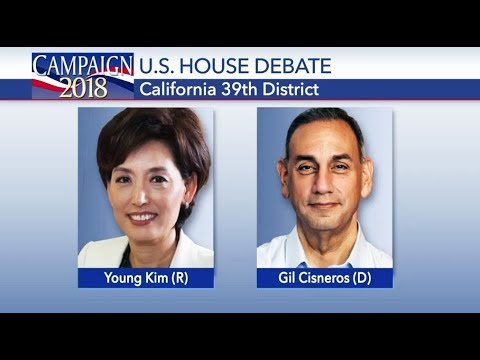by WorldTribune Staff, November 29, 2018
The midterm election defeat of Republican candidate Young Kim in California’s 39th congressional district shows how “California Democrats have systematically undermined California’s already-weak voter protection laws to guarantee permanent one-party rule,” a former California Republican Party chairman wrote in an op-ed.

Kim, who would have been the first Korean-American woman elected to Congress, held a 14-point lead on election night, but by the time all ballots were counted one week after the Nov. 6 election, Democrat Gil Cisneros was declared the winner with 110,794 votes to Kim’s 107,774.
In the open primary to fill the seat of retiring 13-term Republican Rep. Ed Royce, which included 17 candidates, Kim had the most votes (30,019) while Cisneros was second (27,469).
In a Nov. 27 op-ed for The Washington Times, Shawn Steel wrote that Kim’s 14-point lead “was the lone bright spot on an otherwise dismal night for Orange County Republicans. But, over the next week, Republicans watched the first-generation immigrant’s lead evaporate. With thousands of provisional ballots left to count, her commanding lead was underwater. She lost one week after the election.”
Steel, a former California Republican Party chair and California’s current committeeman for the Republican National Committee, noted that “There’s no evidence of ballot box shenanigans. No need. Democrats know it’s easier to erode voter integrity laws than to stuff ballot boxes.”
Steel reeled off the ways he says Democrats are eroding those laws:
- Motor Voter Fraud: Every person in California that interacts with the Department of Motor Vehicles is automatically registered to vote. The state’s Motor Voter program has come under fire for double registering as many as 77,000 people and registering as many as 1,500 ineligible voters. The state’s bipartisan oversight agency expressed concerns about “serious problems with ensuring that the New Motor Voter Program works as intended and promised.” In October, the Little Hoover Commission called for an independent audit of the program and warned that “voter confidence in a fair and legitimate electoral process will be undermined, if not shattered.”
- Ballot Harvesting: Illegal in most states. But not California. As if it wasn’t enough for every person to be automatically registered to vote and receive a ballot, Democrats have made it easier for their campaign operatives to collect those absentee ballots. In 2016, state lawmakers eliminated the ballot protection law that enabled only a trusted family member to return another voter’s ballot. Assembly Bill 1921 now allows anyone to return an absentee ballot. The law has encouraged campaign operatives to engage in coercive tactics. One Democrat voter described coercive intimidation tactics employed by a Democrat campaign in a 2017 special election, leading even the liberal Los Angeles Times editorial board to criticize the law.
- Non-Citizen Voting: California has expanded voter eligibility – with some communities granting illegal immigrants the right to vote. In 2016, San Francisco approved a measure that allows “people in the country illegally and other noncitizens the right to vote in a local election,” according to the Associated Press. This year, San Francisco spent $310,000 in tax dollars to register 49 non-citizens to vote in a school board election.
- Inmate Voting: Alameda County organized taxpayer-funded voter registration drives in county jails to register a record number of inmates. California law allows convicted criminals in county jails, on probation, on mandatory supervision, on post-release community supervision, or on federal supervised release to vote.
- Felon Voting: By downgrading numerous crimes from felonies to misdemeanors, Proposition 47 has enfranchised tens of thousands of convicted criminals previously barred from voting while on parole. The state’s prisoner early release program has also expanded the voter rolls. In 2015, 60,000 convicted felons officially regained their voting rights after the state refused to appeal a lower-court decision that would have denied them the right to vote.
- 16-and-17 Year-Old Pre-Registration: This cycle also marked the beginning of California’s pre-voter registration program for 16- and 17-year-olds. Of course, if every voter is automatically registered through the Motor Voter program, why would anyone need to pre-register? Pre-registration is a thinly-veiled effort to capture voters while they’re young and more likely to identify as liberal Democrats. Of the nearly 89,000 minors that participated in the program, only 10 percent registered as Republicans.
- Absentee Ballots Automatically Mailed to Every Voter: In 2016, California approved a new law that allows counties to mail every voter an absentee ballot whether they requested one or not.
- Ballots Accepted Up to Week After Election Day: In California, voting doesn’t stop on Election Day. Absentee ballots need only be postmarked by Election Day, with ballots counted that arrive up to three days late. If ballots are sent to the wrong county, the ballot is valid for an additional four days.
- Second Chance for Rejected Ballots: Just 50 days before the election, Democrats snuck in one more change to the state’s absentee voting laws. In September, Gov. Jerry Brown signed into law Senate Bill 759, which requires elections officials to notify every voter whose ballot was rejected due to a mismatched signature.
“This election, a 14-point lead wasn’t enough for a Republican victory,” Steel wrote. “By 2020, a 20-point lead on Election Night won’t be safe.”
Check Out Geostrategy-Direct __________ Jump Start the U.S. Media
